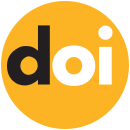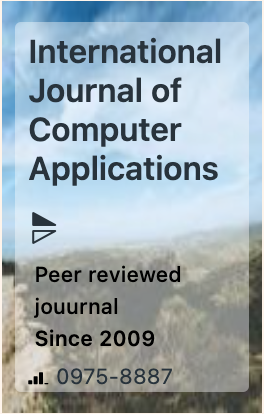The week's pick
Random Articles
Reseach Article
Revolutionizing Healthcare: A Comprehensive Analysis of the Impact of Internet of Things
| International Journal of Computer Applications |
| Foundation of Computer Science (FCS), NY, USA |
| Volume 186 - Number 68 |
| Year of Publication: 2025 |
| Authors: Abubakar Bello Bada, Aminu Aliyu, Hafsat Mahe Omar |
 10.5120/ijca2025924495
10.5120/ijca2025924495
|
Abubakar Bello Bada, Aminu Aliyu, Hafsat Mahe Omar . Revolutionizing Healthcare: A Comprehensive Analysis of the Impact of Internet of Things. International Journal of Computer Applications. 186, 68 ( Feb 2025), 9-14. DOI=10.5120/ijca2025924495
Abstract
The Internet of Things (IoT) which refers to a system of interconnected wireless digital devices that have the ability to collect, transmit, and store data autonomously, without the need for human intervention. The Internet of Things (IoT) has affected many fields. In healthcare, it is highly useful in linking professionals, equipment, and sensors to deliver high-quality services anywhere, at any time, and even in remote areas. This is particularly helpful as accessing health facilities can become very difficult in some situations, as witnessed during the Coronavirus (COVID-19) pandemic. The advancement of IoT technology and its application in healthcare has created new solutions and opportunities in healthcare provision, such as the remote monitoring and treatment of patients. IoT in healthcare has reduced the cost of healthcare, improved patient safety, and enhanced healthcare operational efficiency and accessibility. This paper provides in-depth information on the impact of IoT in healthcare, the challenges affecting it, and the current trends in IoT in healthcare. Methods to mitigate security challenges facing healthcare IoT and future recommendations on current trends are discussed in this paper.
References
- B. Pradhan, S. Bhattacharyya, and K. Pal, “IoT-Based Applications in Healthcare Devices,” 2021, Hindawi Limited. doi: 10.1155/2021/6632599.
- Research and Markets, “Internet of Things(IoT) in Healthcare,” 2019.
- J. T. Kelly, K. L. Campbell, E. Gong, and P. Scuffham, “The Internet of Things: impact and implications for healthcare delivery,” 2022, doi: 10.2196/preprints.20135.
- A. Rejeb et al., “The Internet of Things (IoT) in healthcare: Taking stock and moving forward,” Internet of Things, vol. 22, pp. 2542–6605, 2023, doi: 10.1016/j.iot.2023.100721.
- H Peng, Y. Tian, J. Kurths, L. Li, Y. Yang, and D. Wang, “Secure and energy-efficient data transmission system based on chaotic compressive sensing in body-to-body networks,” IEEE Trans Biomed Circuits Syst, vol. 11, no. 3, pp. 558–573, 2017.
- F. Mirsparsa and A. Mirzaei, “IoT Application in Hospitals,” Journal of Medical Education and Development, Sep. 2022, doi: 10.18502/JMED.V17I2.10616.
- A. Bajaj, M. Bhatnagar, and A. Chauhan, “Recent Trends in Internet of Medical Things: A Review,” pp. 645–656, 2021, doi: 10.1007/978-981-15-5243-4_61.
- Z. Ali, M. S. Hossain, G. Muhammad, and A. K. Sangaiah, “An intelligent healthcare system for detection and classification to discriminate vocal fold disorders,” Future Generation Computer Systems, vol. 85, pp. 19–28, Aug. 2018, doi: 10.1016/J.FUTURE.2018.02.021.
- Cynerio, “The State of Healthcare IoT Device Security 2022.” Accessed: Jan. 12, 2024. [Online]. Available: https://www.cynerio.com/landing-pages/the-state-of-healthcare-iot-device-security-2022
- S. Prakash Dash, “The Impact of IoT in Healthcare: Global Technological Change & The Roadmap to a Networked Architecture in India,” 2020. doi: 10.1007/s41745-020-00208-y.
- Z. N. Aghdam, A. M. Rahmani, and M. Hosseinzadeh, “The Role of the Internet of Things in Healthcare: Future Trends and Challenges,” Comput Methods Programs Biomed, vol. 199, p. 105903, Feb. 2021, doi: 10.1016/J.CMPB.2020.105903.
- R. Indrakumari, T. Poongodi, P. Suresh, and B. Balamurugan, “The growing role of internet of things in healthcare wearables,” Emergence of Pharmaceutical Industry Growth with Industrial IoT Approach, pp. 163–194, Jan. 2019, doi: 10.1016/B978-0-12-819593-2.00006-6.
- J. Calvillo-Arbizu, I. Román-Martínez, and J. Reina-Tosina, “Internet of things in health: Requirements, issues, and gaps,” Comput Methods Programs Biomed, vol. 208, Sep. 2021, doi: 10.1016/j.cmpb.2021.106231.
- Z. A. Nasiri, M. R. Amir, and H. Mehdi, “The Role of the Internet of Things in Healthcare: Future Trends and Challenges,” 2020, Accessed: Mar. 26, 2022. [Online]. Available: https://pubmed.ncbi.nlm.nih.gov/33348073/
- R. Rayan, C. Tsagkaris, and R. Iryna, “The Internet of Things for Healthcare: Applications, Selected Cases and Challenges,” in Studies in Computational Intelligence, vol. 933, Springer Science and Business Media Deutschland GmbH, 2021, pp. 1–15. doi: 10.1007/978-981-15-9897-5_1.
- Y. Shelke, “Technology Intelligence & IP Research INTERNET OF MEDICAL THINGS Thematic Report By,” 2020.
- A. Heart Association, “What is High Blood Pressure?,” 2021.
- González, M. Chen, and V. Leung, “Mobility Support for Health Monitoring at Home Using Wearable Sensors.,” 2021.
- M. Nour and K. Polat, “Automatic Classification of Hypertension Types Based on Personal Features by Machine Learning Algorithms,” 2020, doi: 10.1155/2020/2742781.
- Kumar and Clark, Clinical Medicine Eighth Edition, 8th ed. Wiley-Blackwell, 2021.
- T. Nguyen Gia et al., “Energy efficient fog-assisted IoT system for monitoring diabetic patients with cardiovascular disease,” Future Generation Computer Systems, vol. 93, pp. 198–211, Apr. 2019, doi: 10.1016/J.FUTURE.2018.10.029.
- F. Soltanian et al., “On-body non-invasive glucose monitoring sensor based on high figure of merit (FoM) surface plasmonic microwave resonator,” Scientific Reports |, vol. 13, p. 17527, 2023, doi: 10.1038/s41598-023-44435-6.
- R. Istepanian, “The potential of Internet of m-health Things ‘m-IoT’ for non-invasive glucose level sensing,” in The 2011 Annual International Conference of the IEEE Engineering in Medicine and Biology Society, Boston, MA, USA., 2020, pp. 5264–5266.
- V. S. Naresh, S. S. Pericherla, P. S. R. Murty, and S. Reddi, “Internet of things in healthcare: Architecture, applications, challenges, and solutions,” Computer Systems Science and Engineering, vol. 35, no. 6, pp. 411–421, Nov. 2020, doi: 10.32604/CSSE.2020.35.411.
- R. Kavitha and C. Niranjana, “Smart Healthcare Monitoring System,” 2019.
- M. Talal et al., “Smart Home-based IoT for Real-time and Secure Remote Health Monitoring of Triage and Priority System using Body Sensors: Multi-driven Systematic Review,” J Med Syst, vol. 43, no. 3, Mar. 2019, doi: 10.1007/s10916-019-1158-z.
- G. Gopal, Suter-Crazzolara C., L. Toldo, and W. Eberhardt, “Digital transformation in healthcare—architectures of present and future information technologies,” Clin. Chem. Lab. Med, pp. 328–335, 2019.
- P. Gope and T. Hwang, “BSN-Care: a secure IoT-based modern healthcare system using body sensor network,” IEEE Sens, 2019.
- A. I. Paganelli et al., “Real-time data analysis in health monitoring systems: A comprehensive systematic literature review,” Mar. 01, 2022, Academic Press Inc. doi: 10.1016/j.jbi.2022.104009.
- Y. Sattar and L. Chhabra, “Electrocardiogram,” StatPearls, Jun. 2023, Accessed: Jan. 09, 2024. [Online]. Available: https://www.ncbi.nlm.nih.gov/books/NBK549803/
- M. A. Serhani, H. T. El Kassabi, H. Ismail, and A. N. Navaz, “ECG monitoring systems: Review, architecture, processes, and key challenges,” Sensors (Switzerland), vol. 20, no. 6, Mar. 2020, doi: 10.3390/S20061796.
- T. Tekeste, “Ultra-low power QRS detection and ECG compression architecture for IoT healthcare devices ,” IEEE Transactions on Circuits and Systems I: Regular Papers, pp. 669–679, 2020.
- J. Bathilde, “Continuous heart rate monitoring system as an IoT edge device ,” in 2018 IEEE Sensors Applications Symposium (SAS), Mar. 2019, pp. 1–6.
- U. Acharya, “Application of deep convolutional neural network for automated detection of myocardial infarction using ECG signals,” Inf Sci (N Y), pp. 196–198, 2017.
- Medscape, “Malaria: Practice Essentials, Background, Etiology.” Accessed: Jan. 10, 2024. [Online]. Available: https://emedicine.medscape.com/article/221134-overview
- M. Švantner et al., “Statistical Study on Human Temperature Measurement by Infrared Thermography,” Sensors 2022, Vol. 22, Page 8395, vol. 22, no. 21, p. 8395, Nov. 2022, doi: 10.3390/S22218395.
- H. Ota, M. Chao, and Y. Gao, “3D printed ‘wearable’ smart devices for real-time detection of core body temperature,” ACS Sens, vol. 2, no. 7, pp. 990–997, 2019.
- S. Nookhao, V. Thananant, and T. Khunkhao, “Development of IoT Heartbeat and Body Temperature Monitoring System for Community Health Volunteer,” 2020 Joint International Conference on Digital Arts, Media and Technology with ECTI Northern Section Conference on Electrical, Electronics, Computer and Telecommunications Engineering, ECTI DAMT and NCON 2020, pp. 106–109, Mar. 2020, doi: 10.1109/ECTIDAMTNCON48261.2020.9090692.
- I. K. A. A. Aryanto, I. P. Wijaya, I. N. R. Hendrawan, and K. Y. E. Aryanto, “A Prototype IoT based Technology for Body Temperature Monitoring,” 3rd International Conference on Cybernetics and Intelligent Systems, ICORIS 2021, 2021, doi: 10.1109/ICORIS52787.2021.9649631.
- “Constitution of the World Health Organization.” Accessed: May 13, 2022. [Online]. Available: https://www.who.int/about/governance/constitution
- Zhu, “Smart healthcare in the era of internet-of-things,” IEEE Consumer Electronics Magazine, pp. 26–30, 2019.
- M. Manchala, H. Bommala, V. R. Raju, and R. Pant, “IoT-Based System for Automated Accident Detection and Rescue,” E3S Web of Conferences, vol. 430, Oct. 2023, doi: 10.1051/E3SCONF/202343001159.
- S. Vimal, Y. H. Robinson, S. Kadry, H. V. Long, and Y. Nam, “IoT Based Smart Health Monitoring with CNN Using Edge Computing 173,” 2021, doi: 10.3966/160792642021012201017.
- K. Pradhan and P. Chawla, “Medical Internet of things using machine learning algorithms for lung cancer detection,” Journal of Management Analytics, vol. 7, no. 4, pp. 591–623, 2020.
- Z. Liu, C. Yao, H. Yu, and T. Wu, “Deep reinforcement learning with its application for lung cancer detection in medical Internet of Things,” Future Generation Computer Systems, vol. 97, pp. 1–9, 2019.
- M. Laspro, L. Groysman, A. N. Verzella, L. L. Kimberly, and R. L. Flores, “The Use of Virtual Reality in Surgical Training: Implications for Education, Patient Safety, and Global Health Equity,” 2023, doi: 10.3390/surgeries4040061.
- S. Nazir, Y. Ali, N. Ullah, and I. García-Magariño, “Internet of Things for Healthcare Using Effects of Mobile Computing: A Systematic Literature Review,” Wirel Commun Mob Comput, vol. 2019, 2019, doi: 10.1155/2019/5931315.
- H. Ahmadi, G. Arji, L. Shahmoradi, R. Safdari, M. Nilashi, and M. Alizadeh, “The application of internet of things in healthcare: a systematic literature review and classification,” Univers Access Inf Soc, vol. 18, no. 4, pp. 837–869, Nov. 2020, doi: 10.1007/S10209-018-0618-4/TABLES/6.
- C.-A. Jorge, R.-M. Isabel, and R.-T. Javier, “Internet of things in health: Requirements, issues, and gaps,” Comput Methods Programs Biomed, p. 106231, Sep. 2021, doi: 10.1016/J.CMPB.2021.106231.
- P. Ratta, A. Kaur, S. Sharma, M. Shabaz, and G. Dhiman, “Application of Blockchain and Internet of Things in Healthcare and Medical Sector: Applications, Challenges, and Future Perspectives,” 2021, doi: 10.1155/2021/7608296.
- B. Al-Shargabi and S. Abuarqoub, “IoT-enabled healthcare: Benefits, issues and challenges,” ACM International Conference Proceeding Series, Nov. 2020, doi: 10.1145/3440749.3442596.
- M. Kumar et al., “Healthcare Internet of Things (H-IoT): Current Trends, Future Prospects, Applications, Challenges, and Security Issues,” 2023, doi: 10.3390/electronics12092050.
- S. P. Amaraweera and M. N. Halgamuge, “Internet of Things in the Healthcare Sector: Overview of Security and Privacy Issues,” Security, Privacy and Trust in the IoT Environment, pp. 153–179, 2019, doi: 10.1007/978-3-030-18075-1_8.
- P. Panchatcharam and S. Vivekanandan, “Internet of Things (IOT) in Healthcare – Smart Health and Surveillance, Architectures, Security Analysis and Data Transfer: A Review,” https://services.igi-global.com/resolvedoi/resolve.aspx?doi=10.4018/IJSI.2019040103, vol. 7, no. 2, pp. 21–40, Jan. 2021, doi: 10.4018/IJSI.2019040103.
- R. Somasundaram and M. Thirugnanam, “Review of security challenges in healthcare internet of things,” Wireless Networks 2020 27:8, vol. 27, no. 8, pp. 5503–5509, May 2020, doi: 10.1007/S11276-020-02340-0.
- D. N. Le, L. Le Tuan, and M. N. Dang Tuan, “Smart-building management system: An Internet-of-Things (IoT) application business model in Vietnam,” Technol Forecast Soc Change, vol. 141, pp. 22–35, Apr. 2019, doi: 10.1016/J.TECHFORE.2019.01.002.
- S. Mohapatra and P. K. Sahoo, “Internet of Medical Things: Applications and Research Issues in Healthcare Monitoring,” pp. 1–31, 2022, doi: 10.1007/978-3-030-91096-9_1.
- S. Ketu and P. K. Mishra, “Internet of Healthcare Things: A contemporary survey,” Journal of Network and Computer Applications, vol. 192, Oct. 2021, doi: 10.1016/j.jnca.2021.103179.
- Adril, “IoT in healthcare: applications, benefits, and challenges.” Accessed: Jan. 09, 2024. [Online]. Available: https://stfalcon.com/en/blog/post/iot-in-healthcare-benefits-challenges
- L. Minh Dang, M. Jalil Piran, D. Han, K. Min, and H. Moon, “electronics A Survey on Internet of Things and Cloud Computing for Healthcare,” 2020, doi: 10.3390/electronics8070768.
- H. Habibzadeh, K. Dinesh, O. Rajabi Shishvan, A. Boggio-Dandry, G. Sharma, and T. Soyata, “A Survey of Healthcare Internet-of-Things (HIoT): A Clinical Perspective,” IEEE Internet Things J, vol. 7, no. 1, pp. 53–71, Jan. 2020, doi: 10.1109/JIOT.2019.2946359.
- M. Javaid, A. Haleem, R. P. Singh, S. Rab, M. I. Ul Haq, and A. Raina, “Internet of Things in the global healthcare sector: Significance, applications, and barriers,” International Journal of Intelligent Networks, vol. 3, pp. 165–175, Jan. 2022, doi: 10.1016/J.IJIN.2022.10.002.
Index Terms
Keywords

